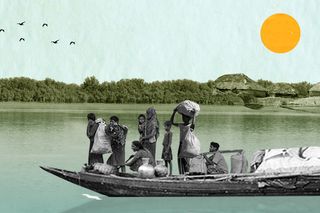
Fleeing Cyclones and Floods for 23 Years: Can Sundarban Residents Outrun a River?
“We’ve been rebuilding our house away from the bank every time a tidal surge washes it away. It seems like we’re running and it’s on the chase.”

“Aamader desh bhasche (Our land is floating),” remarks an old woman as we pass her on the way to the farthest end of Dulki village in Gosaba, Sundarbans. The brick-lined path is narrow and slippery. To one side is the muddied main road of the village, while to the right is what we thought was an endless lake. They are paddy fields so heavily submerged that they’ve taken on the countenance of water bodies.
Considered to be one of the most ecologically sensitive regions globally, the 102 islands of the Indian Sundarbans delta are home to more than 4.6 million people. In the last 25 years, the sea level in the Sundarbans has risen at a rate double that of the global average. Climate Central’s 2019 report projected that the Sundarbans will be completely flooded by 2050, displacing millions.
In the last 23 years, the Sundarbans has witnessed 13 supercyclones. The previous three years saw four cyclones – Fani (2019), Bulbul (2019), Amphan (2020), and Yaas (2021). Some islands have sunk, while others are sinking. In the last decade, thousands of people have lost their homes to rising water levels, ferocious cyclones, and tidal surges. The clock is ticking for many thousand others.
In the middle of the paddy lake is a single-story house, half-submerged with bricks lining its sides. The house’s owner, Mamoni Mondal, informs us that she had taken a loan to build it. Halfway through its construction, the house flooded due to excessive rainfall. Her family has been living in a primary school building for months, and their tale is no different from others living on the Gosaba island.
Mamoni Mondol looking at her house
A 2018 Groundwell report projects that by 2050, without concrete climate action, over 40 million people like Mamoni across South Asia could be forced to move within their own countries to escape the slow-onset impacts of climate change. Climate watchers project an increase in climate migrants by a factor of six between 2020 and 2050. Trapped between rising sea levels and the crumbling economy, the delta between India and Bangladesh is set to become the hotspot of climate-induced out-migration in the coming decades.
The rising water has already submerged islands like Lohachara, Kapasgadi, and Suparibhanga and threatens to erase others from the map. Once inhabited by 40,000 people, Ghoramara island is today on the verge of completely sinking. The 2000 people left on the island struggle to survive. Over the years, its other inhabitants, mostly farmers, have taken refuge on the Sagar island, working as seasonal laborers. Today, Sagar itself is facing the threat of disappearance.
Rising temperatures and cyclones
“We’ve grown old battling storms but have never seen this much devastation. Earlier, the storms were like thieves, now they are like dacoits”, says Dheeren Mondol, 90, the oldest man in Songar. “I’m old and will die soon anyway. But I’m concerned about these kids. Where will they go?” he adds, looking at kids playing with clay on the broken embankment.
Studies have shown that an increase in the severity of cyclones is due to the rise in sea surface temperatures. “The Forest Department tells us pollution is the reason why the water is advancing, so you can see there are only e-rickshaws here. We’d rather use cloth bags instead of plastic,” says Raju, a resident of Dulki village. Ironically, the fate of these islanders is still largely out of their hands.
The devastated villages in the Sunderbans stand testament to this aggravating crisis.
In the village of Pakhiralay, cyclone Yaas had broken the sixth embankment that was constructed on the Gomor river over the years. Standing on the new embankment, Sapan Naskar, 46, points to a small house of tin and thatch, just a few meters away from the river. It’s the fourth house his family has built in the last four decades. “We’ve been rebuilding our house away from the bank every time a tidal surge washes it away. The river has grown four folds in the last decade. It seems like we’re running, and it’s on the chase.”
In the half-kilometer stretch near Naskar’s home, 36 families have lost their homes and about 1 acre of farmlands each to the river, which has come inland for about 1000 feet in the last decade. Naskar dreads his future might lie somewhere else too.
Sapan Naskar standing next to his new house. The embankment behind him is the 6th one.
An endless cycle of rebuilding homes
In Gosaba island, a wave of desperation permeates the air, even though the eventuality of its sinking might be decades away. The villages have suffered a totality of misfortune after cyclone Yaas made its landfall in May, inundating the land with saline water, leaving crops on the field ruined and fishes in the ponds dead. The deposition of salt has rendered swathes of land unfit for cultivation for the coming years. No family on the island has sown paddy last year or this year, effectively losing their livelihoods and food supply for this year.
“Cyclone Yaas broke around 3000 feet of the mud embankment and pulverized 3-4 homes, and then went far into the village,” remarks Chinmoy Sasmal, pointing out a broken bathroom at the shallow end of the Gomor river – the remnants of those homes. “The former tenants now live in rented accommodation in the market area of Gosaba,” he adds.
But Cyclone Amphan was worse. Manmathanagar village on the next island had broken a 5 km long stretch of the embankment, annihilating 30 homes. In its place remains a massive swathe of the river, which has eaten into the island in a semicircle.
Just below this eaten-away embankment lies the two homes of 72-year-old Mrityunjay Bera and his brother. He says that his grandfather had built his home where the next island’s embankment lies today, across the 3 km wide river. And Manmathanagar extended up till that point. Over the years, that river had gradually swept in, submerging over 6 acres of their farmland and several homes.
The family had kept rebuilding their homes inwards, but they had finally reached the limit of their owned property. There was no more land to build another house. And climate change-induced cyclones have only accelerated this internal displacement over the last two decades. “We will die in our homes when the next wave comes,” remarks a dejected Bera.
Remnants of the broken houses on the mud embankment.
Mangroves: the last line of defense
As water claims more land and lives, the delta loses its most potent defense against climate change. Bearing the onslaught of cyclonic winds, waves, and tidal surges, the mangrove forests straddling Sundarbans once extended up to Kolkata. As the population swelled up on these islands during British rule, trees were felled to clear the land for farming. Today, the clear-felling of trees has reduced, but the mangrove cover of the delta is still retreating. Rising sea level due to climate change is flushing out more saline water, weakening the tangled roots of these flood-tolerant trees. Moreover, the construction of dams in the Brahmaputra and Ganga basin has reduced fresh water and sediment supply, further imperiling this ecosystem.
“Each sapling is like a soldier to us that might save our homes in the future,” says Raju, a resident of Dulki, who worked with the forest department to plant 10,000 mangrove saplings near the river bank. “But before the saplings could grow, tidal surges whipped up by the cyclone washed them away.”
It’s with their sheer resilience that people are living in the delta battling not just poverty and extreme weather events but apathy and inaction too. Long before they sink, the islands are becoming inhabitable. Hence, a report published by World Wildlife Fund in 2011 and another published by the World bank in 2014 suggest ‘planned retreat’ of the population and regeneration of mangroves in the vacated vulnerable zone as the only long-term vulnerability reduction strategy.
“The community’s well-being is getting diminished; the in-situ adaptation modes in the forms of infrastructure like embankments are useless in the long run. The delta is likely to face insurmountable challenges in coping with the pressures of predicted changes, particularly in the face of population growth and the impacts of climate change. Phased out-migration of the population and their gradual integration into the urban areas is likely to lead to a successful long-term outcome”, the report reads.
State apathy
Apart from strategies around planting mangroves and building embankments, the state ‘climate action plan’ doesn’t have much to offer. The government deals with the evacuations followed by cyclones within the provisions of disaster management policies at the state level. Despite millions getting displaced each year, at the policy level, India lacks long-term strategies for managing displacement and migration arising from slow-onset events such as the sea-level rise and coastal erosion.
Climate change is driving people out of the sinking islands, forcing them to take refuge in the hinterland. Those who are still holding on are fighting a losing battle with water inching closer every day. Losing their homes, lands, and livelihoods, residents of the delta today might make up the biggest block of climate refugees tomorrow.
Wading through knee-deep sludge to speak to us, Shondha Bera of Dulki says, “I’ve heard our village will drown underwater one day. We are doomed. Kintu kothaay jabo (But where will we go)?”
Shaswata is a journalist from Kolkata who writes on music, culture, and environment. He can be found on Instagram at @otherworldlygaze and on Twitter at @ShaswataKundu. Rashmi is a Delhi-based campaigner working in the intersection of climate change, social movements, and gender justice at Jhatkaa.org. You can reach out to her on Twitter at @donotrushmee and Instagram at @_rushmenot.
Related


The Great Social Cost of Facebook Prioritizing Profit Over Minimum Public Good
